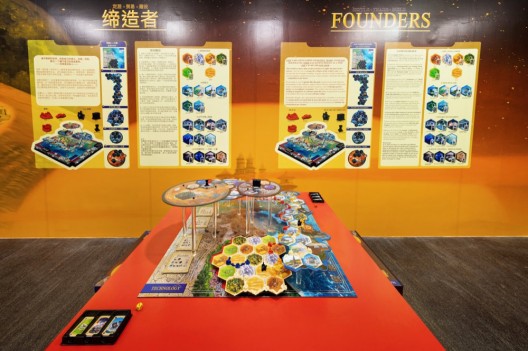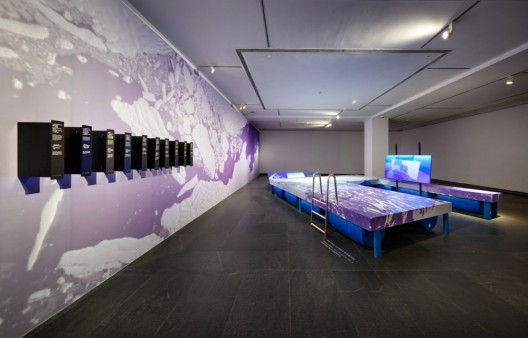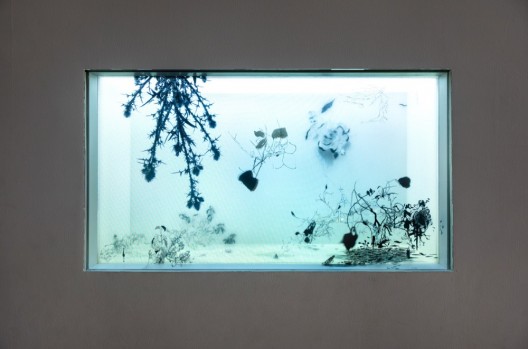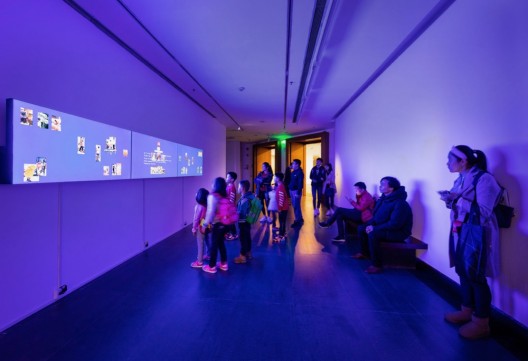by Marcus Yee (余昱昀)
“As We May Think: Feedforward”, The 6th Guangzhou Triennial 2018,
Guangdong Museum of Art
Dec 21,2018 – March 10, 2019
Curated by Angelique Spaninks, ZHANG Ga, Philipp Ziegler. Chief Director: Wang Shaoqiang
The last two decades of precipitous change have provided much grist for recent exhibitions, artist talks, and essays. The pre-eminence of digital technologies in society, the unpredictable advances in biotechnology and Artificial Intelligence, and irreversible environmental degradation encapsulated under the banner of the Anthropocene all speak to a certain disquiet towards unproblematic notions of progress. The latest edition of the Guangzhou Triennial, “As We May Think: Feedforward” is no different.
A cursory scan through the Triennial revealed an emporium of automatons, beakers, screens, vitrines, chemicals, graphs, charts, digital prints, CGI renders, editing software screen-captures, drone footage, Internet-sourced montages, pixelated prints. While the co-curators aspired to dislodge science from hermetically sealed professionalization (with the polymathic ideal of the Renaissance as an aspiration), objects and images in the exhibition not only left disciplinary boundaries intact, they reinforced these boundaries through the exhibition’s overdetermined technoscientistic aesthetic.
Much of the Triennial smacks of techno-optimism. “As We May Think”, the first half of the Triennial’s title, is taken from a 1945 essay by American engineer Vannevar Bush. Written after the explosion of scientific and technological development during World War II, Bush sermonizes about a rose-tinted future that “Science” will pave for humanity. Bush speculated on the “Memex”, an automaton that would organize the ocean of information into an algorithmically navigable series of punch cards. Since the Memex actualized into present-day search engine giants like Google, the Triennial’s co-curators lapped on Bush’s prescience. What was conspicuously undiscussed was Bush’s nostalgia for military science as the coordinator of a WWII submarine radar research laboratory or his deep-seated American nationalism—one example of the lack of historical and epistemological attentiveness symptomatic to the Triennial as a whole.
The second part of the title, “Feedforward”, borrows from an essay by the literary scholar Mark Hansen, which concerns the computational world of machinic sensing where consciousness and perception have sunken to sub-conscious and sub-perceptual levels. Experience now takes a “feed-forward” structure oriented towards the near future, no longer tied to the past (as compared to the feedback loop) nor determined by deliberative consciousness. For Hansen, this human-technological reconfiguration is “a veritable invigoration of the human”, that is, what makes us extra-human, rather than merely posthuman. However, appropriated by the Triennial, Hansen’s theory of the “feedforward” has less to do with the possibilities of social and ethical changes that technology could support, than cheerful, banal speculations on the ontological ripples that result from our nosedive into technological futures. In a technological future that mirrors the exploitation, oppression, and resentment of today, what difference would reflections over human ontologies make?
To be fair, the curators do lay out their stance. In an interview with Angelique Spaninks, one of the three co-curators of the Triennial, she observed, “You can tell the catastrophic and the dark sides of the digital and bio-technologic and I think a lot of art focuses on this side of it, but there is also the other side. The side of hope.” The issue at hand, is not the co-curator’s opaque techno-optimism, but rather, the utopia/dystopia binary. Instead of considering “the digital and bio-technologic” as conditions of the past and present, the Triennial tends to project its discourse on techno-science into the distant, teleological future, hence privileging the task of speculation over critique.

Simon Denny, “Founders Board Game Display Prototype (China Edition)”, customized Settlers of Catan game piece
Case in point is the overwhelming selection of “speculative” works. Works such as Simon Denny’s Founders Board Game Display Prototype (China Edition) or Femke Herregraven’s Sprawling Swamps—Docking Station #2. The former is a display of fictional board-game where the entrepreneurial “founder” evacuates damaged lands to found new colonies in New Zealand, the ocean, and finally, outer space, recalling the blurring between of entrepreneurship, financial technology, and geopolitics through game theory. On the other hand, the latter brings together vaporwave-like animated sequences and insipid swathes of vinyl stickers, making tangential parallels between natural landscapes and finance by imagining “fictional infrastructures”. Both works offer coy, defanged shades of corporate critique, reminiscent of a Reddit meme—leaving audiences cold with the cynical aesthetics of “i guess we r all screwed lol”.
Curiously, an aesthetics of innocence was paired with techno-science throughout the Triennial, as though to diffuse the technological cynicism of the “speculative”. An unsettling naivety was found in Charlotte Jarvis’s Music of Spheres, where DNA-soap bubbles were encoded with musical recordings, or Shen Ruijun’s animation-installation, Shoal, featuring a miniaturised, prelapsarian garden, recalling a familiarly modern romanticism for an untainted Nature. Perhaps the most arbitrary of childlike invocation was Ief Spincemaille’s reticulating 60-meter ROPE, meant for audiences to play with. Left untouched at the OCT Boxes Museum, the work resembled an oversized pet python, abandoned after its skin was dyed blue out of a cruel whim. In a bid to render techno-science approachable through an aesthetics of innocence, such an aesthetics also highlights the ineffectuality of contemporary art in the forcefields of power. Instead of revealing “art’s distinctive power of theorizing powerlessness” (in the words of Sianne Ngai, in The Cuteness of the Avant-Garde), works in the Triennial sublimated feelings of powerlessness altogether, transmogrifying vulnerability into inanity.
With its emphasis on the “Feedforward” motor of history, the Triennial invested mainly in a dubious “contemporary” and “future”, jettisoning imports from world history. For the co-curators, science and technology occupied the empty, progressive time of modernity bereft of the past or the Occident’s Other, where “a new reality descends in which inherited wisdom no longer suffices.” As one of the few historiographical works in the Triennial, ZKM | Hertz Lab’s Genealogy of the Digital Code makes disappointing oversights in its recapitulation of computing history. Genealogy begins its timeline in 1820, when Charles Xavier patented the Arithmometer, “the first industrial calculator for the four main operations”. Instead of retracing continuity, the Genealogy, following the encomiastic tradition—the Great Man Theory of History—violently dismembered the history of computing by erasing the non-Western contributions to arithmetic, such as the Chinese abacus or the Indian-Arabic invention of positional numeration, or erasing the erasure of women’s contributions to computing since the 18th century. The term “computer”, for instance, first referred to unpaid or low-wage workers, who were usually female, tasked to undertake long and tedious calculations.
In the Triennial, it seemed easier to wax theoretical about human and non-human alliances, rather than articulating the political consequences of history upon gender and race in techno-science.
But there were important exceptions in the Triennial. Zhang Yongji’s video installation, The Generation Is Screaming, was one of the few works that brought the context of China in discourse with the digital. Stringing together wildly popular viral dance videos into a montage, The Generation Is Screaming doubles as a visual ethnography of internet participation and virtual pleasures, while alluding to the ambivalent political potential of such online communities.
Harun Farocki’s video series, Parallel I and Parallel II, examined the visualities of computer game imagery—with one work from the series censored days leading up to the Triennial’s opening. Tracing the history of animating nature in computer games, Parallel I begins with the computer-generated winds that blow against treetops, moving poetically through modes of representation, and concludes by revealing the hidden labor behind these animations. In Parallel II, audiences follow game avatars as they travel towards the limits of virtual worlds. Beyond the edges of these worlds, the avatars are walled off or entirely obliterated, turning on its head the opening question, “does the world exist if I’m not watching it?”
With works like those of Zhang and Farocki, the technological is not projected into a fantastical or unliveable future as an object of incessant speculation, but fully apprehended as a condition of the present, informed by the continuities of history. Unlike the overreaching universalization of the (post)human, such works are particular in their espousal of the human, social, and technological as always-already heterogenous, cross-pollinating formations, rather than monolithic entities which therefore could be overcome. This edition of the Guangzhou Triennial could be diagnosed a common case of far-sightedness, where the co-curators casted their sights at the hazy distance of the future and the West, while leaving what is nearby overlooked.
References
Bush, Vannevar. “As We May Think.” The Atlantic, 1945.
Chapman, Lara. “Ups and Downs of the Guangzhou Triennial with Angelique Spaninks.” TLmagazine, 24 Jan. 2019, tlmagazine.com/guangzhou-triennial-as-we-may-think-feedforward-angelique-spaninks/.
Conner, Clifford D. A People’s History of Science. Nation Books, 2005.
Spaninks, Angelique, Zhang Ga, Ziegler, Philipp. “As We May Think: Feedforward”, The 6th Guangzhou Triennial, ed. Wang Shaoqiang, 2018.
Hansen, Mark B. N. Feed-Forward: on the Future of Twenty-First-Century Media. University of Chicago Press, 2015.
Meyer, Michal. “The Rise and Fall of Vannevar Bush.” Science History Institute, Science History Institute, 8 Aug. 2018, www.sciencehistory.org/distillations/magazine/the-rise-and-fall-of-vannevar-bush.
Ngai, Sianne. “The Cuteness of the Avant-Garde.” Critical Inquiry, vol. 31, no. 4, 2005, p. 811.

Yang Jian, “Forest of Sensors”, installation, sensors, various materials, size variable, 2008, ongoing (Courtesy the artist)

Gilberto Esparza, “Autophotosynthetic plants (Phytonucleum electricus cella)”, polycarbonate, stainless steel, electronic circuits, wood, silicone, graphite, silica, sand, activated carbon and acrylic, 2 m × 5 m × 5 m, 2013–2014

Thomas Feuerstein, “PROMETHEUS DELIVERED”, biochemical installation, consisting of: marble, plastic, tubes, stainless steel tub, wood, scissor lift table, 260 cm × 145 cm × 80 cm, 2016–2018

Thomas Feuerstein, “PROMETHEUS DELIVERED”, biochemical installation, consisting of: marble, plastic, tubes, stainless steel tub, wood, scissor lift table, 260 cm × 145 cm × 80 cm, 2016–2018

Lynn Hershman Leeson, “The Infinity Engine”, wallpaper, 2 lab doors, pedestals with perspexhoods, variable dimension, 2014
》,灯、发动机、摄像机、显示器、沛纳海手表等混合媒体,162.56cm×337.82cm×271.78cm,2016-年-528x352.jpg)
Jon Kessler, “The World is Cuckoo (Clock)”, mixed media with lights, motor, video cameras, monitors and Panerai watch, 162.56 cm × 337.82 cm × 271.78 cm, 2016










、电子产品、Scoby(细菌、酵母共生培养物),150cm×80cm×80cm,2017-年,,图为第六届广州三年展现场-528x780.jpg)



